[English] 日本語
 Yorodumi
Yorodumi- PDB-7s88: Open apo-state cryo-EM structure of human TRPV6 in glyco-diosgeni... -
+ Open data
Open data
- Basic information
Basic information
| Entry | Database: PDB / ID: 7s88 | ||||||||||||||||||
|---|---|---|---|---|---|---|---|---|---|---|---|---|---|---|---|---|---|---|---|
| Title | Open apo-state cryo-EM structure of human TRPV6 in glyco-diosgenin detergent | ||||||||||||||||||
 Components Components | Transient receptor potential cation channel subfamily V member 6 | ||||||||||||||||||
 Keywords Keywords |  MEMBRANE PROTEIN / Transient Receptor Potential V Family Member 6 / TRP / channel / apo / open / MEMBRANE PROTEIN / Transient Receptor Potential V Family Member 6 / TRP / channel / apo / open /  human / human /  TRPV6 TRPV6 | ||||||||||||||||||
| Function / homology |  Function and homology information Function and homology informationparathyroid hormone secretion / regulation of calcium ion-dependent exocytosis /  TRP channels / calcium ion import across plasma membrane / calcium ion homeostasis / TRP channels / calcium ion import across plasma membrane / calcium ion homeostasis /  calcium channel complex / calcium ion transmembrane transport / calcium channel complex / calcium ion transmembrane transport /  calcium channel activity / response to calcium ion / calcium ion transport ...parathyroid hormone secretion / regulation of calcium ion-dependent exocytosis / calcium channel activity / response to calcium ion / calcium ion transport ...parathyroid hormone secretion / regulation of calcium ion-dependent exocytosis /  TRP channels / calcium ion import across plasma membrane / calcium ion homeostasis / TRP channels / calcium ion import across plasma membrane / calcium ion homeostasis /  calcium channel complex / calcium ion transmembrane transport / calcium channel complex / calcium ion transmembrane transport /  calcium channel activity / response to calcium ion / calcium ion transport / calcium channel activity / response to calcium ion / calcium ion transport /  calmodulin binding / identical protein binding / calmodulin binding / identical protein binding /  metal ion binding / metal ion binding /  plasma membrane plasma membraneSimilarity search - Function | ||||||||||||||||||
| Biological species |   Homo sapiens (human) Homo sapiens (human) | ||||||||||||||||||
| Method |  ELECTRON MICROSCOPY / ELECTRON MICROSCOPY /  single particle reconstruction / single particle reconstruction /  cryo EM / Resolution: 2.69 Å cryo EM / Resolution: 2.69 Å | ||||||||||||||||||
 Authors Authors | Neuberger, A. / Nadezhdin, K.D. / Sobolevsky, A.I. | ||||||||||||||||||
| Funding support |  Germany, 5items Germany, 5items
| ||||||||||||||||||
 Citation Citation |  Journal: Nat Commun / Year: 2021 Journal: Nat Commun / Year: 2021Title: Structural mechanisms of TRPV6 inhibition by ruthenium red and econazole. Authors: Arthur Neuberger / Kirill D Nadezhdin / Alexander I Sobolevsky /  Abstract: TRPV6 is a calcium-selective ion channel implicated in epithelial Ca uptake. TRPV6 inhibitors are needed for the treatment of a broad range of diseases associated with disturbed calcium homeostasis, ...TRPV6 is a calcium-selective ion channel implicated in epithelial Ca uptake. TRPV6 inhibitors are needed for the treatment of a broad range of diseases associated with disturbed calcium homeostasis, including cancers. Here we combine cryo-EM, calcium imaging, and mutagenesis to explore molecular bases of human TRPV6 inhibition by the antifungal drug econazole and the universal ion channel blocker ruthenium red (RR). Econazole binds to an allosteric site at the channel's periphery, where it replaces a lipid. In contrast, RR inhibits TRPV6 by binding in the middle of the ion channel's selectivity filter and plugging its pore like a bottle cork. Despite different binding site locations, both inhibitors induce similar conformational changes in the channel resulting in closure of the gate formed by S6 helices bundle crossing. The uncovered molecular mechanisms of TRPV6 inhibition can guide the design of a new generation of clinically useful inhibitors. | ||||||||||||||||||
| History |
|
- Structure visualization
Structure visualization
| Movie |
 Movie viewer Movie viewer |
|---|---|
| Structure viewer | Molecule:  Molmil Molmil Jmol/JSmol Jmol/JSmol |
- Downloads & links
Downloads & links
- Download
Download
| PDBx/mmCIF format |  7s88.cif.gz 7s88.cif.gz | 479.7 KB | Display |  PDBx/mmCIF format PDBx/mmCIF format |
|---|---|---|---|---|
| PDB format |  pdb7s88.ent.gz pdb7s88.ent.gz | 416.6 KB | Display |  PDB format PDB format |
| PDBx/mmJSON format |  7s88.json.gz 7s88.json.gz | Tree view |  PDBx/mmJSON format PDBx/mmJSON format | |
| Others |  Other downloads Other downloads |
-Validation report
| Arichive directory |  https://data.pdbj.org/pub/pdb/validation_reports/s8/7s88 https://data.pdbj.org/pub/pdb/validation_reports/s8/7s88 ftp://data.pdbj.org/pub/pdb/validation_reports/s8/7s88 ftp://data.pdbj.org/pub/pdb/validation_reports/s8/7s88 | HTTPS FTP |
|---|
-Related structure data
| Related structure data |  24890MC  7s89C  7s8bC  7s8cC M: map data used to model this data C: citing same article ( |
|---|---|
| Similar structure data |
- Links
Links
- Assembly
Assembly
| Deposited unit | 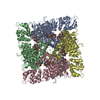
|
|---|---|
| 1 |
|
- Components
Components
-Protein , 1 types, 4 molecules ABCD
| #1: Protein | Mass: 78421.328 Da / Num. of mol.: 4 Source method: isolated from a genetically manipulated source Source: (gene. exp.)   Homo sapiens (human) / Gene: TRPV6, ECAC2 / Production host: Homo sapiens (human) / Gene: TRPV6, ECAC2 / Production host:   Homo sapiens (human) / References: UniProt: Q9H1D0 Homo sapiens (human) / References: UniProt: Q9H1D0 |
|---|
-Non-polymers , 5 types, 209 molecules 








| #2: Chemical | ChemComp-Y01 / #3: Chemical | ChemComp-PCW / #4: Chemical | ChemComp-POV / (  POPC POPC#5: Chemical | ChemComp-CA / | #6: Water | ChemComp-HOH / |  Water Water |
|---|
-Details
| Has ligand of interest | N |
|---|
-Experimental details
-Experiment
| Experiment | Method:  ELECTRON MICROSCOPY ELECTRON MICROSCOPY |
|---|---|
| EM experiment | Aggregation state: PARTICLE / 3D reconstruction method:  single particle reconstruction single particle reconstruction |
- Sample preparation
Sample preparation
| Component | Name: sample 1 / Type: COMPLEX / Entity ID: #1 / Source: RECOMBINANT | ||||||||||||||||||||||||||||||
|---|---|---|---|---|---|---|---|---|---|---|---|---|---|---|---|---|---|---|---|---|---|---|---|---|---|---|---|---|---|---|---|
| Molecular weight | Units: MEGADALTONS / Experimental value: NO | ||||||||||||||||||||||||||||||
| Source (natural) | Organism:   Homo sapiens (human) Homo sapiens (human) | ||||||||||||||||||||||||||||||
| Source (recombinant) | Organism:   Homo sapiens (human) Homo sapiens (human) | ||||||||||||||||||||||||||||||
| Buffer solution | pH: 8 | ||||||||||||||||||||||||||||||
| Buffer component |
| ||||||||||||||||||||||||||||||
| Specimen | Conc.: 3 mg/ml / Embedding applied: NO / Shadowing applied: NO / Staining applied : NO / Vitrification applied : NO / Vitrification applied : YES / Details: human TRPV6 in glyco-diosgenin detergent : YES / Details: human TRPV6 in glyco-diosgenin detergent | ||||||||||||||||||||||||||||||
| Specimen support | Grid material: GOLD / Grid mesh size: 300 divisions/in. / Grid type: UltrAuFoil R1.2/1.3 | ||||||||||||||||||||||||||||||
Vitrification | Instrument: FEI VITROBOT MARK IV / Cryogen name: ETHANE / Humidity: 100 % / Chamber temperature: 277 K |
- Electron microscopy imaging
Electron microscopy imaging
| Experimental equipment |  Model: Titan Krios / Image courtesy: FEI Company |
|---|---|
| Microscopy | Model: TFS KRIOS |
| Electron gun | Electron source : :  FIELD EMISSION GUN / Accelerating voltage: 300 kV / Illumination mode: FLOOD BEAM FIELD EMISSION GUN / Accelerating voltage: 300 kV / Illumination mode: FLOOD BEAM |
| Electron lens | Mode: BRIGHT FIELD Bright-field microscopy / Nominal defocus max: -2000 nm / Nominal defocus min: -1000 nm / Cs Bright-field microscopy / Nominal defocus max: -2000 nm / Nominal defocus min: -1000 nm / Cs : 2.7 mm : 2.7 mm |
| Image recording | Average exposure time: 3 sec. / Electron dose: 58 e/Å2 / Film or detector model: GATAN K3 (6k x 4k) / Num. of grids imaged: 1 / Num. of real images: 7904 |
| Image scans | Width: 5760 / Height: 4092 |
- Processing
Processing
| EM software |
| ||||||||||||||||||||||||||||||||||||||||||||
|---|---|---|---|---|---|---|---|---|---|---|---|---|---|---|---|---|---|---|---|---|---|---|---|---|---|---|---|---|---|---|---|---|---|---|---|---|---|---|---|---|---|---|---|---|---|
CTF correction | Type: NONE | ||||||||||||||||||||||||||||||||||||||||||||
| Particle selection | Num. of particles selected: 3117068 | ||||||||||||||||||||||||||||||||||||||||||||
3D reconstruction | Resolution: 2.69 Å / Resolution method: FSC 0.143 CUT-OFF / Num. of particles: 276688 / Symmetry type: POINT | ||||||||||||||||||||||||||||||||||||||||||||
| Atomic model building | Space: REAL | ||||||||||||||||||||||||||||||||||||||||||||
| Atomic model building | PDB-ID: 7K4A |
 Movie
Movie Controller
Controller





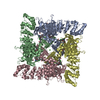
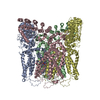

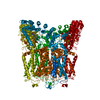
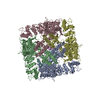
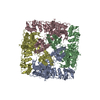




 PDBj
PDBj






